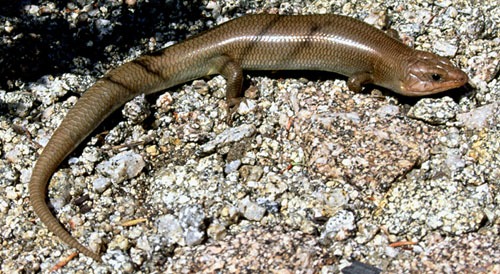- Gilbert's Skink
Taxobox
name = Gilbert's Skink

image_width = 200px
status = NE
status_system = iucn3.1
regnum =Animal ia
phylum = Chordata
classis = Reptilia
ordo =Squamata
familia =Scincidae
genus = "Eumeces "
species = "E. gilberti"
binomial = "Eumeces gilberti"
binomial_authority = Van Denburgh, 1896
synonyms = "Plestiodon gilberti"
Smith, 2005Gilbert's Skink ("Eumeces gilberti") is a heavy-bodied medium-sized
lizard of the family ofskink s living in the south-westernUnited States . It grows to about 7 to 12 cm (2.75 to 4.75inch es) total length.Taxonomy
"Eumeces gilberti" was first described by Van Denburgh in 1896. It was named in honor of Van Denburgh's teacher, Dr. Charles H. Gilbert (1859 - 1928), who at the time was a professor of
zoology atStanford University .There are five
subspecies of "Eumeces gilberti":
*Arizona Skink ("E. g. arizonensis"); Lowe and Shannon, 1954
*Greater Brown Skink ("E. g. gilberti"); Van Denburgh, 1896
*Northern Brown Skink ("E. g. placerensis"); Rodgers, 1944
*Variegated Skink ("E. g. cancellosus"); Rodgers and Fitch, 1947
*Western Red-tailed Skink ("E. g. rubricaudatus"); Taylor, 1935("E.g. placerensis" got its name from
Placer County, California , where it occurs.)Together with the
Western Skink ("E. skiltonianus"), theSan Lucan Skink ("E. lagunensis"), and theFour-lined Asiatic Skink ("E. quadrilineatus"), the Western Skink belongs to the so-called "skiltonianus" group". The exact taxonomy within this group is being questioned and may need revision followingDNA analysis research.Range and Habitat
Gilbert's Skink occurs mainly in
California . It is found in the northernSan Joaquin Valley , in the foothills of the Sierra Nevada from Butte County southward, and along the inner flanks of the Coast Ranges fromSan Francisco Bay to the Mexican border and into northernBaja California . It is also found in the mountains of southern California, and at scattered mountain localities in the eastern desert from Mono County to San Bernadino County. Isolated populations also occur in westernArizona as well as in southernNevada .Gilbert's Skink occurs in habitat ranging from sea level to elevations of about 2200 m (7300 ft). Found in a wide variety of habitats, this lizard is commonest in early successional stages or open areas within habitats in which it occurs, which ranges from grassland to open
chaparral or open pine forests. Heavy brush and densely forested areas are generally avoided.Description
Gilbert's Skink is a heavy-bodied lizard with small legs. Adults are uniformly colored in green, grey, olive or brown. Juveniles have light stripes on the sides and the back enclosing a broad black or brown stripe. This dark stripe stops near base of a waxy-pink tail. The striping fades with growth and maturation.
This robust skink is seldom seen in the open. It forages through leaf litter and dense vegetation, occasionally digging through loose soil. It is a good burrower and often constructs its own shelter by burrowing under surface objects such as rocks or rotting logs. Females construct nest chambers in loose moist soil several centimeters deep, especially under flat stones.
The reproductive season for this species varies geographically and from year to year depending on local conditions. Little is known about the timing of reproduction, but it is probably similar to the
Western Skink . Clutch size varies from 3 to 9 eggs.ee also
*
Broad-headed Skink - similar morphologyExternal links
* [http://www.werc.usgs.gov/fieldguide/eugi.htm Gilbert's Skink] at the
U.S. Geological Survey .
* [http://www.dfg.ca.gov/whdab/html/R037.html Gilbert's Skink] at the California Department of Fish and Game.
*eol|16722129
Wikimedia Foundation. 2010.
